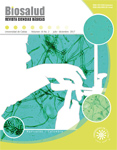Authors
Abstract
This paper shows the implementation of Electrical Impedance Spectroscopy (EIS) in the characterization of the cervical columnar tissue and as a supporting tool to the diagnostic techniques of cervical cancer. Methods: A diagnostic validity study was performed on 30 non-menopausal patients who presented cervical ectopy during colposcopy. A total of 129 electric impedance spectra of columnar tissue was obtained, which were differentiated into four measurement zones or points similar to time zones 12, 3, 6, and 9 of an analog clock. The experimental data obtained were adjusted to the Cole-Cole model which describes the physiology and structure of the tissue through electrical resistivity parameters R and S, characteristic frequency Fc and membrane capacitance Mc. Results: The comparison between healthy and damaged columnar tissue at each of the measurement points was performed using non-parametric Mann– Whitney U tests which showed statistically significant differences (p <0.05) for the R and S medians with a 95% confidence level. The average values of R and S for healthy columnar tissue were 2.0 Ω-m and 11.36 Ω-m, with 0.41 and 0.51 standard deviation respectively, whereas for a damaged tissue the average value of R and S were 4.21 Ω-m and 7.03 Ω-m, with 0.40 standard deviation for both measurements. Conclusions: It was found that the resistivity of the extracellular liquid R, and the resistivity of the intracellular matrix S, are the parameters that better discriminate between healthy columnar epithelia and those affected by lesions.
References
2. Ministerio de Salud y Protección Social, Instituto Nacional de Cancerología ESE. Plan decenal para el control del cáncer en Colombia 2012 - 2021, Bogotá, D.C; 2012.
3. Piñeros M, Pardo C, Gamboa O, Hernández G. Atlas de mortalidad por cáncer en Colombia. I.G.A.C. e Instituto Nacional de Cancerología, eds. Imprenta Nacional: Bogotá, Colombia; 2010.
4. Brown B, Tidy J, Boston K, Blackett A, Smallwood R, Sharp F. Relation between tissue structure and imposed electrical current flow in cervical neoplasia. THE LANCET, 2000, 355.
5. Tan JH, Wrede CD. New technologies and advances in colposcopic assessment. Best Practice & Research Clinical Obstetrics and Gynaecology, 2011. 25: p. 667–677.
6. Olarte G, Aristizábal W, Gallego P, Rojas J, Botero B, Osorio G. Detección precoz de lesiones epiteliales del cuello uterino en mujeres de Caldas - Colombia - mediante la técnica de espectroscopia de impedancia eléctrica. Revista Colombiana de Obtetricia y Ginecología, 2007. 58(1): p. 13-20.
7. Brown B. Tissue Impedance Spectroscopy and Impedance Imaging, in Comprehensive Biomedical Physics, A. Brahme, Editor; 2014, Elsevier.
8. Walker D, Brown B, Blackett A, Tidy J, Smallwood R. A study of the morphological parameters of cervical squamous epithelium. Physiological Measurement, 2003. 24: p. 121-135.
9. Abdul S, Brown B, Milnes P, Tidy J. The use of electrical impedance spectroscopy in the detection of cervical intraepithelial neoplasia. International Journal of Gynecological Cancer, 2006; 16: p. 1823- 1832.
10. Olarte G, Aristizábal W, Gallego P. Evaluation of electrical impedance spectroscopy for cervical intraepithelial lesions detection. Revista Biosalud, 2015; 14(1): p. 26-35.
11. Fletcher C. Diagnostic Histopathology of Tumors, in tumor the female genital tract, E.H. Sciences, Editor 2013; Elsevier Health Sciences. p. 814-824.
12. Ministerio de Salud. Normas científicas, técnicas y administrativas para la investigación en salud. 1993, Ministerio de Salud: República de Colombia.
13. Mayeaux EJ, Werner C, Shfaq R, Bartholomew D, Flowers L, Garcia F, et al. THE CERVIX: Colposcopy: Brief history of colposcopy. Section on the Cervix for use by physicians and healthcare providers;2010.
14. O’Connor D. A Tissue Basis for Colposcopic Findings. Obstetrics and Gynecology Clinics of North America, 2008; 35(4): p. 565-582.
15. Germar M. Visual inspection with acetic acid as a cervical cancer screening tool for developing countries. In Review prepared for the 12th Postgraduate Course in Reproductive Medicine and Biology. 2003. Geneva, Switzerland: World Health Organization.
16. Grimnes S & Martinsen O. Bioimpedance & Bioelectricity Basics. Second Edition, Elsevier, Academic Press. 2008; p. 283-332.
17. Dean D, Ramanathan T, Machado D, Sundararajana R. Electrical impedance spectroscopy study of biological tissues. Journal of Electrostatics, 2008; 66: p. 165–177.
18. Ivorra A. Bioimpedance Monitoring for physicians: an overview. Biomedical Applications Group, 2002.
19. Gregory W, Marx J, Gregory C, Mikkelson W, Tjoe J, Shell J. The Cole relaxation frequency as a parameter to identify cancer in breast tissue. Medical Physics, 2012; 39(7).
20. Corzo P, Miranda D, García E, Estupiñán Y, González C. Citología de cuello uterino e impeditividad eléctrica en la detección temprana del cáncer cervical. Salud UIS, 2012; 44(2): p. 15-19.
21. Caicedo S, Rojas J, Betancurt S, Aristizábal W, Chavarro J. Algoritmos Genéticos Difusos para el Ajuste del Modelo de Cole-Cole; 4to Congreso Colombiano de Computación; 2009.
22. Balasubramani L, Brown B, Healey J, Tidy J. The detection of cervical intraepithelial neoplasia by electrical impedance spectroscopy: The effects of acetic acid and tissue homogeneity. Gynecologic Oncology, 2009; 115: p. 267-271.

 pdf (Español (España))
pdf (Español (España))
 FLIP
FLIP


















